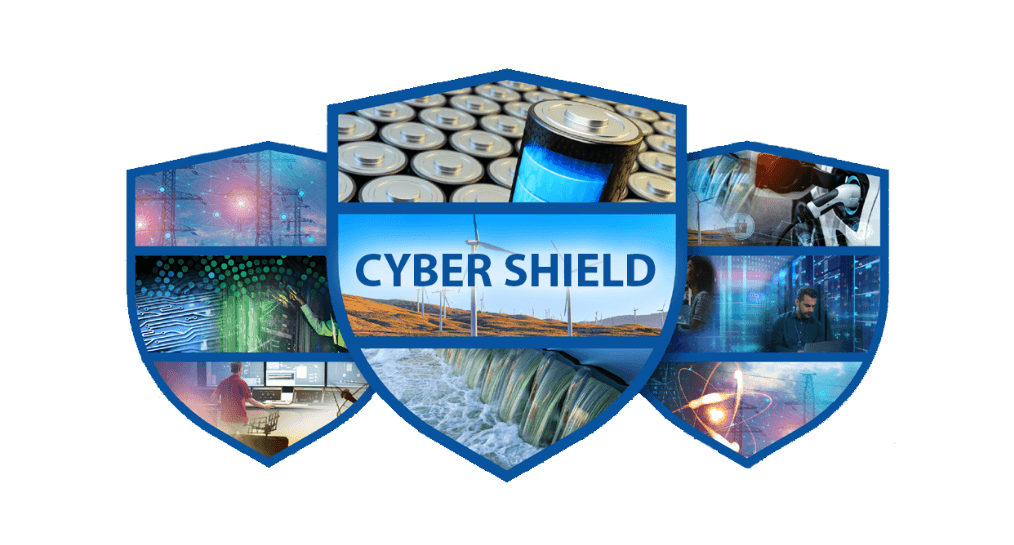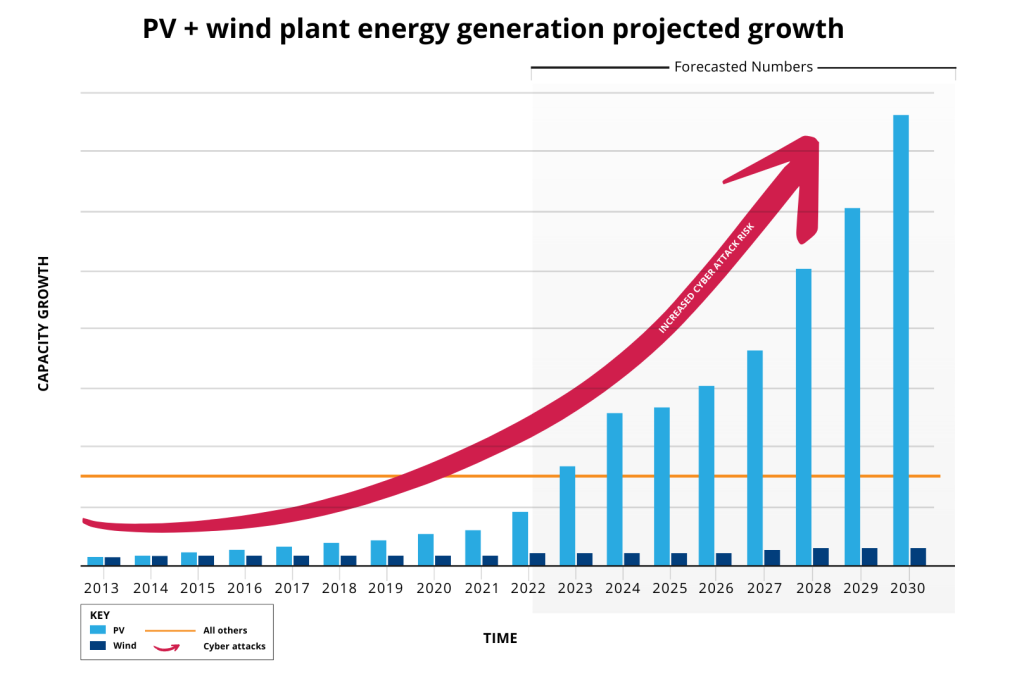INL Resilience Optimization Center
CyberSHIELD for Alternative Energy
Security through Hardware Integration, Education, and Layered Defense
CyberSHIELD is an Idaho National Laboratory (INL) initiative aimed at helping owner/operators of integrated energy generation secure and protect infrastructure and ensure the transition to the energy grid of the future is secure. By leveraging robust tools developed under Department of Homeland Security (DHS) programs, the initiative seeks to raise the floor in cybersecurity for intermittent energy and accommodate any level of cyber maturity. The mission is to protect wind, solar and water energy infrastructure from cyber risks by deploying risk analysis tools. Within a decade, integrated energy is expected to become the leading generation source in our grids. The program is available to all renewable asset owner/operators.

Become a CyberSHIELD Partner
The INL CyberSHIELD Program is funded by the Department of Energy, and is a collaborative effort between the Wind Energy Technologies Office (WETO), Water Power Technologies Office (WPTO), and Solar Energy Technologies Office (SETO).
INL CyberSHIELD tools and assessments are open-source, and INL-hosted engagements are available to utility-scale renewable owner/operators.
Let us help you chart a more secure cyberinfrastructure path.
Available INL CyberSHIELD Program Benefits
- Cybersecurity Threat and Risk Mitigation: The fast-paced evolution of technology and the growing cyber threat landscape highlight the need to improve security in the intermittent energy sector to facilitate a successful transition.
- Operational and Cybersecurity Resilience: Our program offers intermittent energy owner/operators predictive tools to develop adaptation and resilience strategies that will allow them to address cyber threats in a proactive manner.
Direct Benefits for Asset Owner/Operators
- Understanding Asset-Level Risks: Understand Asset-Level Risks: Gain a better understanding of your assets, your asset-level risks, devices, protocols, vulnerabilities, and potential misconfigurations.
- Increased Network Reliability: Increase network visibility to enable more informed decisions and improve reliability.
- Network Architecture Mapping: Gain the ability to map network architecture within the assessment to control areas to help identify or validate your cyber posture.
- Identification of System Weaknesses and Vulnerabilities: Identify potential attacks, vulnerabilities and active exploits specific to your assets/devices.
- Guided Cybersecurity Assessment: Together, through guided cybersecurity assessment, we will produce a risk-based report to enhance cybersecurity programs leveraging established frameworks tuned for the intermittent asset sector.
- Expert Cyber Program Support: Immediate access to supporting cyber programs and resource planning capabilities to quickly meet maturity objectives.
Renewable Assets Benefiting from CyberSHIELD
INL ROC’s multi-disciplinary team leverages world-class research, facilities, and capabilities to analyze the state of system resilience and develop unique, value-conscious, and mission-driven solutions.
Wind
Wind energy production is expected to double to 20% of US electrical energy production by 2030. Wind energy is expected to grow to 35% by 2050, with a significant portion coming from offshore wind.
Solar
Solar energy is expected to be the largest growth driving an exponential scale from 3%-5% of total US electrical energy production to 30% by 2030. From 2024 to 2050, solar facilities will make up 80% of the expansion of intermittent energy. This figure includes utility-scale and small-scale home solar systems.
Water
Hydroelectric plants account for approximately 6-7% of total US electrical energy production. As intermittent energy continues to grow, our 2100 hydroelectric plants will be called upon to compensate to support the variability.
Inverter Based
Energy Storage
Inverters are the power electronics in intermittent energy (wind and solar) that convert direct current (DC) electricity, to alternating current (AC) electricity, which the electrical grid uses.
Intermittent Energy’s Role and the Security Imperative
The number of generation plants will increase significantly over the next decades, correspondingly increasing the potential cyber attack surface. The rapid and frequent evolution of technology and the cyber threat landscape brings urgency to the importance of maturing security within the renewable sector to support the effective transition.
Regulatory Compliance & Legal Readiness
The future grid will look much different than today’s and will require more reliability standards. The Federal Energy Regulatory Commission (FERC) has issued an order for reliability and registration standards for wind, solar, and storage in the future grid. The order aims to protect the grid by focusing on unregistered resources that may have a material impact on the reliability of the Bulk-Power System. The North American Electric Reliability Corporation (NERC) may already register resources with an individual material impact.
FERC and NERC Critical Infrastructure Protection (CIP) Revisions include the following:
- Requirement(s) for authentication of remote users before access is granted to networks containing low-impact BES Cyber Systems at assets comprising those systems with external routable connectivity.
- Requirement(s) for protecting user authentication information (e.g., combinations of usernames and passwords) for remote access to low-impact BES Cyber Systems at assets containing those systems with external routable connectivity.
- Requirement(s) for detecting malicious communications to/between low-impact BES Cybers Systems at assets comprising those systems with external routable connectivity.
INL CyberSHIELD Analysis and Implementation Process
INL CyberSHIELD is designed to minimize the level of effort from your teams (understanding resources are often thin). Additionally, a key aspect of INL CyberSHIELD is the ability to adjust to different levels of cybersecurity maturity levels, no matter what level of maturity you are this program and engagement can help guide your next steps in improving your cyber posture.
Customer information protection and confidentiality considerations have been integrated. Outcomes and deliverables focused on identifying risk, mitigation plans, and prioritization. The participants’ needs and resource availability guide the effort and duration engagement level.
To support the “raise the floor” objectives, the initial focus has been the deployment of three initiatives. These tools are designed to provide asset owner/operators with a step-by-step process to evaluate and mitigate cybersecurity risks, from performing a program assessment and mapping system architecture to a full asset interaction analysis toward cyber maturity.
INL CyberSHIELD Renewables Cybersecurity Tools
Part of what makes INL CyberSHIELD effective is the ability to adapt to different levels of cybersecurity maturity of organizations and drive to benefits. We leverage multiple robust tools developed under DHS programs. These tools are tuned for use with renewable assets and accommodate any level of cyber maturity with a primary goal of helping owner/operators identify vulnerabilities and chart a course to improve cyber maturity. The program’s cornerstone tools are the MALCOLM-AIA (Asset Interaction Analysis Tool) and the CSET (Cyber Security Evaluation Tool).
Provides renewable entities access to a cybersecurity assessment with cyber controls applied for OT environment providing risk-based recommendations for improving their maturity.
An assessment tool to map network architecture and obtain awareness of common design-related risks and mitigation options.
This tool allows entities to work on an assessment from their own network architecture.

INL Malcolm-AIA – Asset Interaction Analysis: Leveraging Malcolm for the renewable industry. Passively deployable on your network to inks assets to business processes and translate the business processes to OT devices. Supports deeper threat and vulnerability identification/analysis for users. Geared to do the analysis and detection for you, simplifying many tasks.

The Cyber Security Evaluation Tool (CSET) provides a systematic, disciplined, and repeatable approach for evaluating an organization’s security posture. CSET is a desktop software tool that guides asset owners and operators through a step-by-step process to evaluate industrial control system (ICS) and information technology (IT) network security practices. Users can evaluate their own cybersecurity stance using many recognized government and industry standards and recommendations.
Further Reading: Renewable Energy Cybersecurity Trends
Insurance Policy and Commercial Litigation Trends – No More Wiggle Room
Cyber Insurance professionals will often need to assess the policy-readiness of their clients by examining their current cyber hygiene management according to a set of minimum requirements.
The following resources and articles provide a deeper dive into the renewable energy cybersecurity challenges we face and an overview of recommendations designed to address critical intermittent energy infrastructure challenges in the near term.
Department of Energy Report
Cybersecurity Considerations for Distributed Energy Resources on the U.S. Electric Grid
NERC Inverter-Based Resource Strategy
Ensuring Reliability of the Bulk Power System with Increased Levels of EPS-Connected IBRs
Utility Dive Brief
FERC orders reliability standards, registration requirements for wind, solar, storage to protect the grid, November 2022
“As the name suggests, the Zero-Trust framework works on the basis that no activity of an organizational network is immune from thorough, ongoing security checks. In practice, it is a security approach that requires all users of an organization’s network and third-party providers with continuous access to the network, to be authenticated and authorized on an ongoing basis for security posture before being granted access to applications and data.”
Frequently Asked Questions
What is CyberSHIELD (INL Cyber SHIELD)?
Cyber SHIELD is an initiative developed by Idaho National Labs to raise the floor of cybersecurity for intermittent energy. The initiative focuses on developing a suite of tools, programs, and resources customized for the renewable industry to improve cybersecurity posture and understand cyber risk better.
What tools is Cyber SHIELD based upon?
Cyber SHIELD is developed upon broader tools such as Cyber Security Evaluation Tool (CSET) and Malcolm, both of which are open source and DHS-sponsored tools.
What are cybersecurity assessment tools for the renewable industry?
The Cyber SHIELD initiative leverages multiple robust tools developed under DHS programs. These tools are tuned for use with renewable assets and accommodate any level of cyber maturity with a primary goal of helping owner/operators identify where they are and where to go to improve cyber maturity.
What are the benefits of using Cyber SHIELD?
Cyber SHIELD helps gain a better understanding of assets, including devices, protocols, and configurations, to identify potential cyber-attacks, vulnerabilities, and active exploits with more precision. This increases network visibility, enables informed decisions, and improves reliability. In addition, the ability to map network architecture within the assessment helps identify or validate the cyber posture. It provides immediate access to input supporting cyber programs and resource planning capabilities to meet maturity objectives quickly.
What is the level of effort required by asset owners/operators and asset stake holders for Cyber SHIELD engagements?
Asset owners/operators and asset stakeholders participating in Cyber SHIELD engagement should anticipate allocating time and resources for virtual introduction and technical exchange meetings, as well as onsite visits to support deployment tools and interviews with key personnel in order to properly evaluate participant cybersecurity posture.
Virtual Cyber SHIELD engagements are possible through remote assessment (over Microsoft Teams) for renewable asset owners/operators and stakeholders that do not require network security tools deployed in the participant ICS/OT environment (e.g., Malcolm deployment).
How can I get information on Cyber SHIELD?
Contact INL Cyber SHIELD Team at: [email protected]
Collaborate with INL Cyber SHIELD
The INL Cyber SHIELD team provides technical support and recommended best practices to renewable energy asset owners/operators and stakeholders to address cybersecurity gaps. This is accomplished through technical tool and processes to perform:
- Asset identification/discovery
- Threat detection
- Risk evaluation
Funding Partners
This work was funded by the Solar Energy Technology Office (SETO), the Wind Energy Technology Office (WETO), and the Water Power Technology Office (WPTO) which are part of the Office of Energy Efficiency and Renewable Energy (EERE).
Through Cyber SHIELD engagements, our goal is to enable the asset owner/operators and asset stakeholders to improve their cybersecurity and resilience to cyber threats.
Contact us to provide input or collaborate on the following topics:
- Developing cybersecurity and resilience strategies for the renewable energy sector
- Leveraging predictive cybersecurity tools to identify high-consequence cyber vulnerabilities and potential threats to asset owner/operator assets in the renewable energy sector
- Collaborating to enhance the INL Cyber SHIELD program to develop cybersecurity best practices and mitigation strategies for hardening of renewable energy infrastructure


